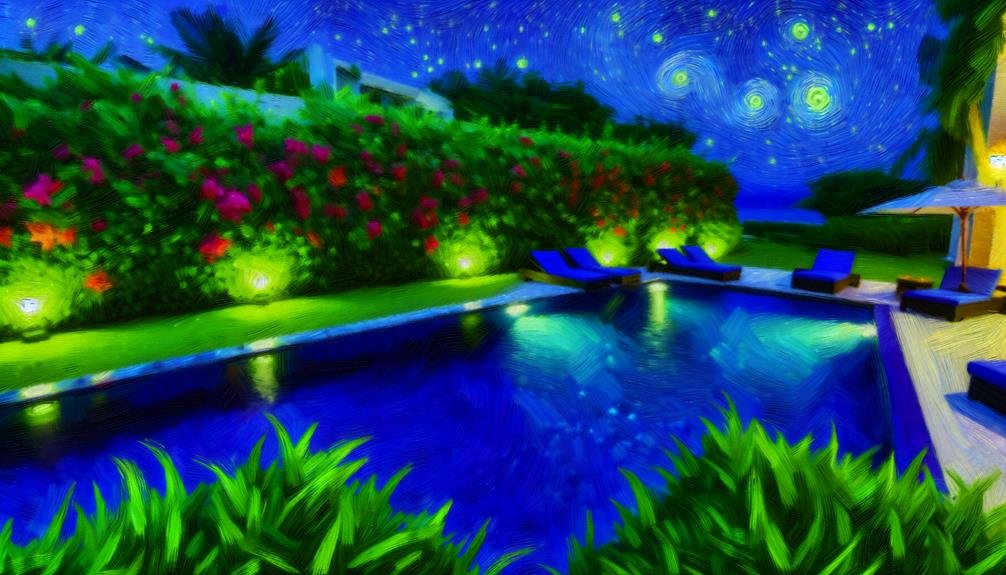Grass around a pool offers several benefits, including improved aesthetic appeal and a comfortable surface for barefoot enjoyment. It fosters a tranquil environment and contributes to increased property value. Nevertheless, it requires regular maintenance, including watering, mowing, and pest control, which can be demanding. Safety issues also arise, as wet grass can lead to slips, while visibility may be hindered for monitoring children. Additionally, environmental impacts must be considered, particularly concerning drainage and chemical use. Each aspect carries weight, influencing your decision on gardening. Investigate further for a deeper understanding of this gardening choice.
Main Points
- Grass enhances the aesthetic appeal of a pool area, creating a vibrant and tranquil environment for relaxation.
- It provides a soft, cushioned surface that is comfortable for barefoot walking and reduces the risk of falls.
- Regular maintenance, including watering, mowing, and weed control, can be time-consuming and challenging.
- Wet grass can pose slipping hazards, especially if drainage is inadequate, affecting safety around the pool.
- Grass helps absorb rainwater and prevents soil erosion, contributing positively to the environment if maintained properly.
Aesthetic Appeal of Grass
The aesthetic appeal of grass surrounding a pool can greatly improve the overall atmosphere of the outdoor space. A well-maintained lawn creates a natural and inviting environment, providing a striking contrast against the cool blue of the pool water. This combination nurtures a tranquil ambiance, encouraging relaxation and leisure activities. The vivid green of the grass boosts the visual appeal, making the area more vibrant and lively. Additionally, incorporating grass can increase property value through visual improvement, similar to the benefits of planting magnolia trees.
Incorporating grass around the pool can also soften the harsh lines of hardscaping elements such as tiles or concrete, creating a more harmonious design. The organic texture of grass serves to balance these materials, leading to a more cohesive look for the entire space. Additionally, grass can serve as a natural border, delineating the pool area from other outdoor features such as gardens or patios.
However, it is essential to take into account maintenance requirements, as a lush lawn demands regular care to maintain its pristine condition. This includes mowing, watering, and fertilization, which can be time-consuming.
Nonetheless, the visual benefits of grass around a pool often outweigh these challenges, making it a popular choice for homeowners seeking to uplift their outdoor aesthetics.
Comfort and Softness Underfoot
A homeowner's choice to surround a pool with grass can greatly improve comfort and softness underfoot, providing a pleasant experience for bare feet. Grass offers a cushioned surface that boosts the complete enjoyment of the pool area, and similar to how advocacy leads to tangible impacts, the choice of grass can considerably improve the outdoor experience.
This natural flooring not only feels good when walking, running, or lounging but also contributes to a more relaxed and inviting atmosphere. The softness of grass can reduce the risk of slips and falls, making it a safer option for families with children.
Unlike hard surfaces such as concrete or stone, grass absorbs impacts and can help prevent injuries from accidental tumbles. In addition, the natural temperature regulation of grass keeps the surface cooler than synthetic materials or stone, making it more comfortable during hot summer days.
Moreover, grass can provide a natural shift between the pool area and surrounding landscaping, creating a seamless and aesthetically pleasing environment. This soft ground cover can encourage longer periods of barefoot enjoyment, boosting the complete experience of outdoor leisure activities.
In the end, the comfort and softness of grass around a pool make it an appealing choice for homeowners seeking a more inviting and enjoyable outdoor space.
Maintenance Requirements and Challenges
Maintaining grass around a pool can be a demanding endeavor, requiring consistent attention and care to guarantee its health and appearance.
The unique environment surrounding a pool—characterized by moisture and foot traffic—can present several challenges for grass maintenance. Additionally, the cost benefits of maintaining a grassy pool area, similar to the advantages offered by NACA's low interest rates, can improve the overall enjoyment and value of your outdoor space.
Here are four key maintenance requirements and challenges to reflect upon:
- Watering Needs: Grass around a pool may need more frequent watering due to evaporation and splashes, necessitating an efficient irrigation system to maintain ideal moisture levels.
- Mowing Frequency: The grass may require regular mowing to keep it at an aesthetically pleasing height, especially with increased foot traffic potentially leading to quicker growth.
- Weed Control: The lush conditions can encourage weed growth, demanding a proactive approach to implement effective weed management strategies and prevent competition for nutrients.
- Fertilization: To maintain vibrant, healthy grass, regular fertilization is essential. This can be complicated by the need to avoid chemical runoff into the pool, necessitating the use of safe, pool-friendly products.
Navigating these maintenance challenges is vital for preserving the beauty and health of the grass surrounding your pool.
Safety Considerations
Ensuring safety around a pool area with grass involves addressing potential hazards that can arise in this unique setting. One of the primary concerns is the risk of slipping, especially when grass becomes wet from splashes or rain. To mitigate this risk, it is essential to maintain a well-drained, healthy lawn that does not remain overly saturated.
Additionally, the presence of grass can attract insects, such as ticks and mosquitoes, which can pose health risks to swimmers. Regular lawn maintenance and pest control measures should be implemented to minimize these threats.
Furthermore, grass can obscure visibility, making it difficult to monitor children or pets near the pool. Implementing clear boundaries, such as fencing or landscaping features, can improve visibility and safety.
Environmental Impact and Drainage
In considering the environmental impact and drainage of grass around a pool, it becomes essential to evaluate how this natural element interacts with water management systems. Grass can influence both the aesthetics and functionality of the pool area, but its consequences for drainage must be carefully assessed.
The following points highlight key considerations regarding environmental impact and drainage:
- Water Absorption: Grass can effectively absorb rainwater, reducing surface runoff and aiding groundwater recharge, which can be beneficial for local ecosystems.
- Soil Erosion: A well-established grass root system can help prevent soil erosion around the pool, stabilizing the terrain and preserving the integrity of the surrounding area.
- Chemical Use: The application of fertilizers and pesticides on grass can lead to chemical leaching into nearby water bodies, potentially harming aquatic life and influencing water quality.
- Drainage Management: Proper grading and drainage systems are critical to guarantee that water does not pool around the pool area, which can lead to unsightly conditions and encourage mosquito breeding.
Common Questions
What Types of Grass Are Best for Poolside Areas?
For poolside areas, ideal grass types include Bermuda, Zoysia, and Fescue. These varieties are durable, resistant to wear, and tolerate moisture, providing a lush, attractive setting while minimizing maintenance and safety concerns for pool users.
How Does Grass Affect Pool Water Temperature?
Grass can influence pool water temperature by providing shade, potentially reducing heat absorption from sunlight. Nevertheless, excessive vegetation may also contribute organic debris, which can affect water quality and temperature regulation if not properly maintained.
Can Grass Attract Pests Near the Pool?
Grass can attract various pests, such as insects and rodents, which may be drawn to the moisture and shelter it provides. Maintaining the surrounding environment is essential to minimize pest-related issues near pool areas.
What Is the Lifespan of Grass Around a Pool?
The lifespan of grass around a pool largely depends on the type of grass, climate conditions, maintenance practices, and foot traffic. Generally, well-cared-for grass can last several years, provided it receives adequate water and nutrients.
Are There Any Eco-Friendly Alternatives to Grass?
Yes, several eco-friendly alternatives to grass exist, including artificial turf, ground cover plants, and permeable paving. These options reduce water usage, minimize maintenance, and improve the aesthetic appeal while supporting local biodiversity and sustainability efforts.
Conclusion
In summary, incorporating grass around a pool presents a blend of aesthetic appeal and comfort, enhancing the general experience of the outdoor space. Nevertheless, challenges related to maintenance, safety concerns, and environmental consequences must be considered. While grass can contribute to a visually pleasing and inviting atmosphere, careful evaluation of its impact on pool safety and drainage is essential for informed decision-making. Ultimately, the choice of landscaping should align with individual priorities and the specific context of the pool area.

